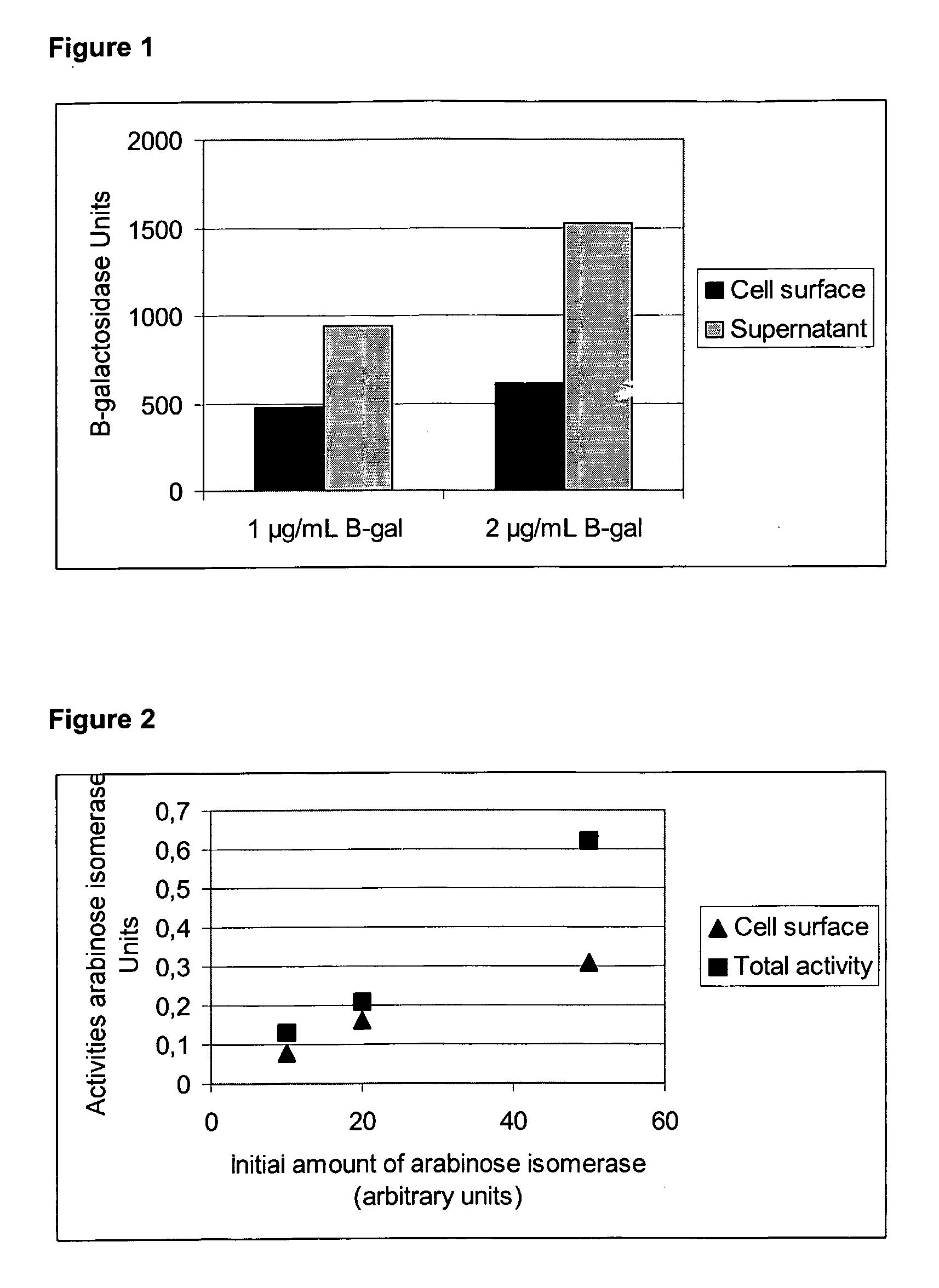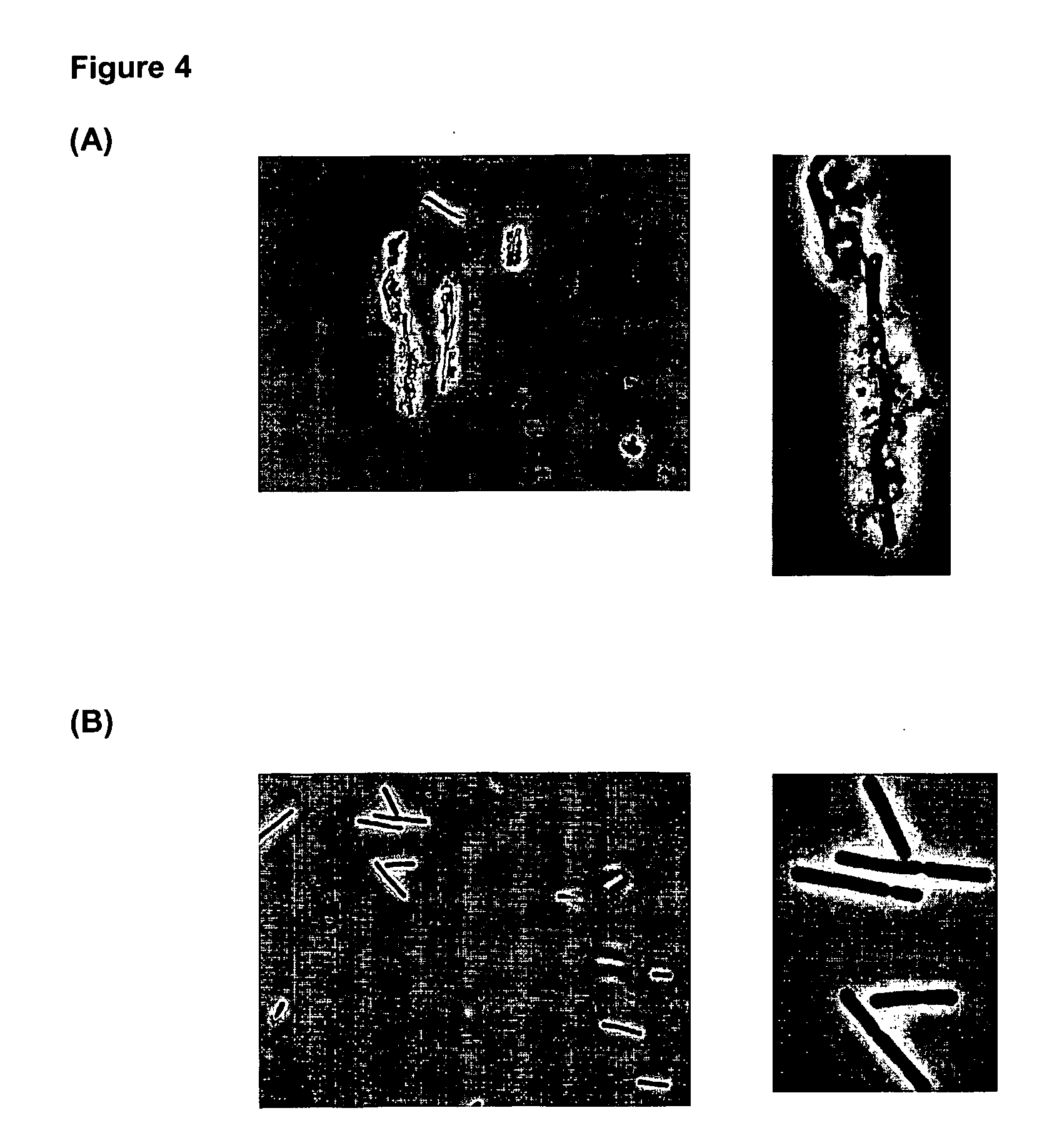Pharmaceutical Composition Comprising a Bacterial Cell Displaying a Heterologous Proteinaceous Compound
a technology of proteinaceous compound and pharmaceutical composition, which is applied in the field of mucosal vaccination, can solve the problems of complicated allergy vaccination, use and release of genetically modified organisms, and bacteria that contain recombinant dna are also considered risks,
- Summary
- Abstract
- Description
- Claims
- Application Information
AI Technical Summary
Benefits of technology
Problems solved by technology
Method used
Image
Examples
example 1
Chemical Cross-Linkage of β-Galactosidase to Lactobacillus by Glutaraldehyde
[0128]This example demonstrates the chemical cross-linkage of the protein β-galactosidase from Sulfolobus solfataricus (Pisani F. M. et al. 1990 Eur J Biochem., 187:321-8) to the cell surface of Lactobacillus plantarum UP1 using the bifunctional cross-linking reagent, glutaraldehyde (GLA), which is a five-carbon dialdehyde. GLA acts as a cross-linker by forming a Schiff-base (—H═N—) with the amino groups of proteins. Thus GLA mediated cross-linkage of β-galactosidase to the bacterial surface is expected to occur between lysine or arginine residues present in the β-galactosidase protein and accessible lysine or arginine residues on, or near, the cell surface of the bacterium.
[0129]The β-galactosidase for cross-linking studies was obtained by recombinant expression in Escherichia coli, using the pET-3a vector system (Invitrogen, CA). Briefly, the lacS gene, encoding β-galactosidase, was amplified by standard P...
example 2
Chemical Cross Linkage of Arabinose Isomerase to Lactobacillus by Glutaraldehyde
[0130]To demonstrate that chemical cross-linking of proteins to the cell surface of a bacterium is not limited to β-galactosidase, we show the cross-linkage of the enzyme arabinose isomerase, from the thermophilic Thermoanaerobacter mathrani, to a bacterial cell. Arabinose isomerase converts D-galactose to D-tagatose and was obtained by recombinant intracellular expression in E. coli as described by Jørgensen and co-workers (Jørgensen F et al. 2004, Appl Microbiol Biotechnol 64:816-22). After growth and expression in recombinant E. coli, the cells were lysed using a French press. This lysed mixture was centrifuged and the supernatant comprising arabinose isomerase was used for the following cross-linking experiment. Lactobacillus plantarum UP1 was grown and washed as described in Example 1. The washed cells (1010 cells) were incubated with different amounts of lysate containing the arabinose isomerase an...
example 3
Chitosan, as Spacer Molecule, Enhances Levels of β-Galactosidase Cross-Linked to Lactobacillus by Glutaraldehyde
[0131]Chitosan is a naturally occurring molecule, containing multiple reactive groups, which can be used as spacer molecule to enhance the amount of protein attached to the surface of the bacterial cell by chemical cross-linkage. L. plantarum cells were grown and washed as described in Example 1, and suspended in M9 buffer at a concentration of 1010 cells per ml, to which 0.5% w / v chitosan 500 kDA (Cognis Deutschland GmbH, Germany), and 0.2% GLA were added, together with either 1 μg / mL or 2 μg / mL β-galactosidase. The effect of chitosan on the cross-linkage of β-galactosidase to cells was compared to a control cross-linking reaction without chitosan. The L. plantarum cells were harvested and washed as described in Example 1 and β-galactosidase catalytic activity of the washed cell fraction and the supernatant of the cross-linking reaction mixture were measured. FIG. 3 demon...
PUM
| Property | Measurement | Unit |
|---|---|---|
| temperature | aaaaa | aaaaa |
| temperature | aaaaa | aaaaa |
| temperature | aaaaa | aaaaa |
Abstract
Description
Claims
Application Information
 Login to View More
Login to View More - R&D
- Intellectual Property
- Life Sciences
- Materials
- Tech Scout
- Unparalleled Data Quality
- Higher Quality Content
- 60% Fewer Hallucinations
Browse by: Latest US Patents, China's latest patents, Technical Efficacy Thesaurus, Application Domain, Technology Topic, Popular Technical Reports.
© 2025 PatSnap. All rights reserved.Legal|Privacy policy|Modern Slavery Act Transparency Statement|Sitemap|About US| Contact US: help@patsnap.com



